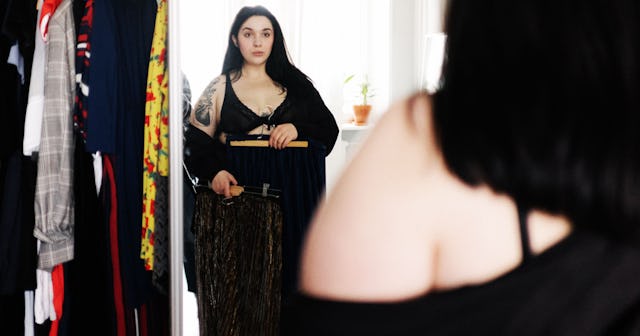We're Inadvertently Sending Kids The Wrong Messages About Beauty And Body Positivity

I used to talk about fat a lot. I used to talk about how I felt fat, how I looked fat, how I needed to lose fat. I talked about dieting, how I couldn’t eat certain foods. But I tried to temper it by pointing out how other body types, skin colors, etc. were beautiful. Basically, I talked about beauty a lot.
Science says that was all a giant mistake.
None of us want to pass our body image issues to our kids. In our daughters, they’ll play out as the same issues, passed down through the generations. In our sons — god, in our sons, they may show up as preferences for a certain type of woman, may lead them to turn down women who don’t meet some fucked up, media-manufactured beauty ideal. We want the buck to stop with us.
Except we’re doing a really, really bad job of it.
A 2016 study, Body Dissatisfaction and Its Correlates in 5- to 7-Year-Old Girls: A Social Learning Experiment, published in Journal of Clinical Child and Adolescent Psychology, found that girls mimic what their mothers say about their own bodies. They had girls talk about their bodies, then listen to their mothers talk about their own, then talk about their bodies again, all in front of a mirror. The girls’ descriptions changed based on what their moms said.
In other words: what we say in front of our kids about our bodies matters. Imagine you describe yourself negatively as fat, then asked your son to describe an ideal female body. Bet he’d say it was thin.
So all my negative fat-talk (which we’ve since banned in our house as toxic in the name of body positivity), and all the negative fat-talk my sons absorb from relatives (which we can’t control) contributes to their view of female bodies. What are we telling our kids when we say our fat bodies are bad bodies, when we constantly discuss dieting and carb-counting and “bad” foods? Both boys and girls absorb these messages, and the messages aren’t good ones.
But my pointing out fat women as beautiful is good, right? I was doing a good thing by naming beauty when I saw it? Just as telling your daughter she’s beautiful is a good thing? Wrong, says The Atlantic. When we do that, we still tell our daughters — and our sons — that women are most valued for their beauty. Sure, we might talk about strong soccer players and brave astronauts. But how much do we also talk about Rapinoe’s purple hair?
Our daughters hear that, sure, it’s great to be brave and smart and strong. But it’s most important to be beautiful. Our sons hear that girls can be brave and smart and strong, but women are at the most important, their most valuable, and their most attractive when they conform to the narrow standards pushed by modern media conglomerates. Yikes.
So maybe everyone’s beautiful? Nope, says The Atlantic. If everyone’s beautiful then no one’s beautiful, and everyone knows that beauty exists. You’re shoving the discussion aside. Moreover, “It’s not everyone’s job to be beautiful,” Renee Engeln, a psychology professor at Northwestern who studies body image and the media, tells The Atlantic. “If what you really mean when you call your daughter beautiful is that she is strong, smart, resilient, or funny, use those more specific adjectives instead.”
Instead, we need to realign our values. The Atlantic recommends valuing bodies for their capabilities: their ability to run and hike, to pilot a wheelchair, rather than to look a certain way. Value food for the way it tastes, for the way it makes you feel full or not full, for its nutritional content, rather than for its caloric content or carb count.
Margo Ovcharenko/Getty
We also need to talk more. Starting from a young age, we need to talk to girls — and to boys — about the way modern media portrayals bodies. While The Atlantic article focuses on girls, as the mother of sons, I know that body image issues can be just as damaging to boys. What do cartoon characters look like, we can ask. Do people look like that in the real world? What do dolls look like? Look at the people on magazine covers and in TV shows: their faces, their hair, their bodies. Do you see people like them walking down the street every day? Why do you think you don’t? Do you see a fair representation of people of color? What about nonbinary people, or people whose appearance may not fit neatly into one gender or another? Where are they?
Most importantly, we can ask our sons and daughters who might benefit from these kinds of images. When you see a model on the cover of a magazine, what might it make you feel, and what might you do in response? When you see a muscular man pumping iron, how would you feel about your body, and what might you feel like you should do? What does it make you feel like girls and boys should look like?
And most importantly: is that realistic, or not?
What should be more important: how someone looks, or other qualities they exhibit? This is what we need to teach our children. Beauty is in the eye of the beholder, and beauty isn’t the thing on the cover of a magazine. True beauty is smart, strong, talented; it’s grit and toughness and persistence, accomplishments and kindness. I want my sons to learn that. And if I do, I need to stop talking about my appearance, good and bad. I need to start praising something else. And the sooner, the better.
This article was originally published on